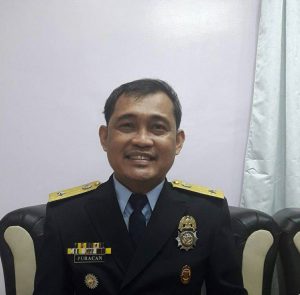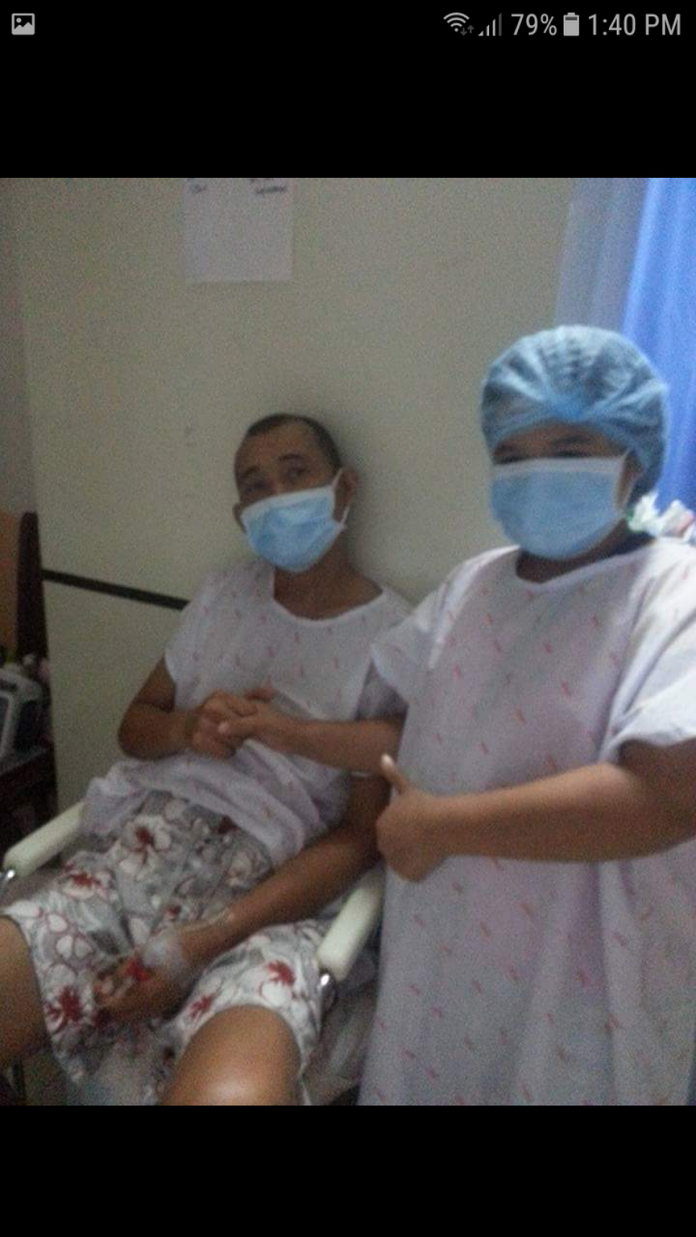“Organ donation is a unique opportunity to help save lives by giving a part of yourself so that others may live.” – National Kidney and Transplant Institute
***
It all started when Louie S. Puracan, a firefighter from Bansalan, Davao del Sur, went to a hospital for his regular medical checkup in 2009. The doctor noticed the creatine level of the patient was increasing.
The doctor was worried knowing the patient was already 41 years old. So he talked with him wanting to find out if what he assumed was right. During their conversation, Louie disclosed that he was 30 when arthritis started to knock him out. To get rid of the agony, he resorted to taking pain relievers. Hearing this revelation, the doctor told him that most pain relievers can cause kidney disease.
The doctor then advised him to undergo a glomerular filtration rate (GFR) to measure the level of his kidney function and determine the stage of kidney disease at the National Kidney and Transplant Institute in Quezon City. (He was working at that time at the Bureau of Fire Protection at Calamba, Laguna).
He did. “The result caused me sleepless nights,” he recalled. “My kidney functions rate was 60% and it was irreversible. Upon hearing that diagnosis, my world seemed to collapse. The only thing doctors could do was to delay the progression.”

Louie then requested for transfer to Davao City to be near his family. His appeal was granted in 2011 and was under the care of Dr. Maria Theresa Bad-ang, a nephrologist. “By that time, I was losing weight, felt dizzy every now and then, and hopeless,” he said.
In 2016, when the result of his GFR test was placed at 21%, Dr. Bad-ang recommended for preemptive transplant. “She didn’t want me to undergo dialysis as it would entail more expenses on my part,” he said. “She advised me to look for possible kidney donor as soon as possible.”
By this time, Louie was getting weak and felt catching his breath. Family members and relatives knew the situation and so a clan meeting was held in Bansalan. Four cousins and his adopted sister volunteered to be his donor.
In January 2017, the doctor stated doing the laboratory work for cross-matching. Here, blood from the donor and recipient are mixed. If the recipient’s cells attack and kill the donor cells, the crossmatch is considered positive. This means the recipient has antibodies “against” the donor’s cells. If the crossmatch is negative, the pair is considered compatible.
His adopted sister, then 30 years old and married with three children, was a perfect match for Louie. “My mother named her Blyssen, which is derived from the word, ‘blessing,’ as there are two of us, all boys – my brother Neil (now a colorectal surgeon) and myself,” he informed. “Little did we know that she is indeed a blessing to all of us, particularly to me.”

His doctor and other fellow kidney patients were so happy that he got a perfect match on his first attempt for a crossmatch. He had his transplant operation on May 16, 2017 but not without a hitch.
“As soon as the surgeons took my sister’s kidney from her body, the kidney turns into grey,” he said. “The doctors gave 40% chance and assured me that the kidney will function in my body. They explained that situation like this happens. Some have even acute kidney rejection right after the transplant.”
After 16 days at the hospital, Louie was finally released from the hospital. “During the next four months, I was in and out of the hospital for nine times,” he said. “It was really a rollercoaster ride. There was a time that I thought of giving up as I can’t bear the pain anymore.”
In addition, he had problem getting sleep and the restless legs syndrome irritated him so much. “The thing that I really hated most is the never-ending episodes of vomiting,” he said. “I vomit almost all day, which causes dehydration and weakens my body.”
To get rid of sleeplessness, the doctors gave him sedatives. In October last year, he had to undergo a kidney biopsy as his transplant team thought he was undergoing kidney rejection. Surprisingly, his creatine level rose to 225%.
“At present, I feel better,” he now says. “I’m back to my work but mindful of my diet. I’m so happy that the Lord extended my life leading me to the right people, my nephrologist and the transplant team. And to my sister, who shared her life with me by giving her kidney. I could not survive the crucial six months period without my family whose prayers and encouragement give me the courage to fight for it.”
Indeed, it was Blessyn’s generosity who saved the life of her brother. It is inspiring but, sadly, not typical. “Thousands of Filipinos die every year of organ failure and the lack of organ donors,” deplored the NKTI. “Many lives can be saved if more Filipinos will donate a part of themselves.”
Take the case of kidney failure alone. Records from the Department of Health show at least one Filipino dies each hour from kidney failure, which is considered the ninth leading cause of death in the country. Some 10,000 Filipinos need kidney transplants from donors every year.
“The survival rate of organ transplants is quite encouraging,” the NKTI said in a statement. Its data showed that the survival rates for kidney transplants during the first year were registered at 90-95% for living-related donors and about 80-85% for diseased organ donors. “These rates are comparable with the survival rates of similar transplants in other parts of the world,” the institute said.
As people live longer, organ diseases and health problems like diabetes – one of the main causes of kidney failure – are expected to rise, creating even greater demand for organ donations.
The good news is: there are now reputable Filipino doctors that can perform transplantation. Aside from that, there are new drugs and improved surgical techniques that can make transplants safer and more successful.
“We have the expertise to save more lives, but many patients die because of lack of available donor organs,” says Dr. Antonio V. Cayco, who practices in internal medicine and specializes in nephrology at the Makati Medical Center. “It is a tragedy for everyone.”
One major reason of the shortage of transplantable organs is that the relatives of people who have died simply haven’t been asked. “Doctors and other health professionals are reluctant to bring the subject of donation to the bereaved family,” said Dr. Enrique Ona, who was NKTI chief transplant surgeon when interviewed by this author. “In some instances, they do not think of organ donation when brain death occurs in their patients.”
Another reason is fear. “There is a fear among the living that organ donation (kidney, for instance) might make them weak, shorten their lives, and affect their sexuality or child-bearing,” Dr. Ona said.
For the uninformed, transplant doctors do not become involved until all efforts have been made to save a patient’s life, the patient has been declared brain-dead, and consent for organ and tissue donation has been confirmed. “For a patient to be an organ donor, he has to be confirmed brain-dead by two medical specialists,” informs Dr. Ona.
Confusion about brain-dead among the families of potential donors, doctors and even hospital administrators is another hindrance of donation of organs. To grieving loved ones, the person looks alive. “People think there might be a miracle, so they hold on,” one doctor contends.
There are also those who are mortified by operation or even death. Some Filipinos consider organ donation as a death wish. Despite the fact the Philippines has passed Republic Act 7170. Also known as Organ Donation Act of 1991, it authorizes “the legacy or donation of all or part of a human body after death for specified purposes.”
But despite all the laws, there is still low turn-out of organ donation. This is true not only in the Philippines but also in other Asian countries. “While medical technology and skills have developed at a rapid pace, the attitudes of society towards organ donation have not changed quite so fast,” points out Associate Professor K. Prabhakaran, director of the Liver Transplant Program at the National University Hospital in Singapore.
More often than not, people who are very close to the dying patient oftentimes turn down request of organ donation. “Public education is probably the most important factor in ensuring organ donation,” believes Dr. Prema Raj Jeyaraj, the surgical director of the liver transplant program in the Singapore General Hospital.
Some people believe that organ donation will disfigure a dead person’s body and delay his funeral. One doctor offers this explanation: “The organs are removed in a sterile operation undertaken by skilled surgeons. The donor is treated with the utmost respect and dignity. When the procedure is finished, the wound is closed, just as in any other operation. The entire process is done quickly to preserve the organs and will therefore not delay a funeral.”
Proper education, it seems, is the key. Perhaps Filipino doctors can learn something from Dr. Ramayee Sinnasamy, senior heart transplant coordinator of the National Heart Institute in Kuala Lumpur. Every time he gives a talk on organ donation, he asks the audience: “When we are alive and in good health, we donate blood as many times as we want. But why aren’t we donating our organs when we are dead and gone? When those organs are not of any use to us anymore?”
Dr. Teodoro J. Herbosa, former health undersecretary, agrees. “Organ donation saves lives and it is very important that every person has the power to save a life by becoming an organ, tissue or eye donor,” he says. “It is a noble gift because you can give someone a second chance at life.”
Although many people believe their religion will not allow organ donations, virtually all major religions support it as a humanitarian act. In the Philippines, the Catholic church allows it for “altruistic motives,” according to the Episcopal Commission on Bioethics of the Catholic Bishops’ Conference of the Philippines (CBCP). “We may donate them as an act of charity,” it said.
The NKTI says about 25 organs and tissues may be donated for transplantation. Aside from kidneys, major organs include the heart, lungs, liver, bowel, pancreas and stomach. The tissues include heart valves, bone and cartilage, bone marrow, corneas and skin.
The lack of organ donors in the Philippines has led to the development of an ugly side of organ transplantation. There are poverty-stricken Filipinos who are selling body organs for a corresponding fee.
This is “morally unacceptable,” the CBCP said. “The dignity of the human person as an image of God includes not only his or her soul but his or her corporeal being. Hence, our body ought not to be treated as a commodity or object of commerce, which would amount to the… plundering of the human body,” it explained in a statement released in 2008.
The NKTI has launched a program called Human Organ Preservation Effort (HOPE) which coordinates organ donation. The institute created HOPE specifically for the retrieval, preservation, and allocation of organs and tissues for clinical transplantation.
Among those who can donate their organs are people who are 18 years or older. “A minor or a person under age 18 may become a donor only if a parent or legal guardian gives consent,” the NKTI said.
People who decides to donate portions of their organs once they die are given organ donor card. “The organ donor card identifies your wish to become an organ donor,” the NKTI explained.
It is by giving part of oneself that others may live. Elisa (not her real name for privacy reason) knows this well. In 1995, her kidneys commenced to deteriorate as a result of the disease she had since she was still a teenager. By 2004, she had a chronic kidney failure and was into a program of dialysis three times a week. Since dialysis treatment is a long process, she explored of getting a kidney transplant.
“My husband tried to donate his other kidney, but it was incompatible with mine,” Elisa recalls. Her brother offered his kidney, too, but she was crushed when the doctor told her that her brother’s kidney does match with her, too.
Since she could not find any donor, she went to another province and eventually found one. On September 30, 2004, she had her kidney transplantation. “My body has very strong resistance towards foreign organs,” Elisa laments. “It went into acute rejection on the fifth day of the transplant while I was still in the hospital.”
She was flown back to her hometown. Her surgeon administered high dosage of drugs and after two days, the new kidney was activated. “Thank God, I was discharged after one week,” she says.
Elisa is also grateful for that person who donated his organ to her. “I had a new lease of life because someone did that for me before he died,” she says. “Whoever he is, I will always be thankful of him.”







